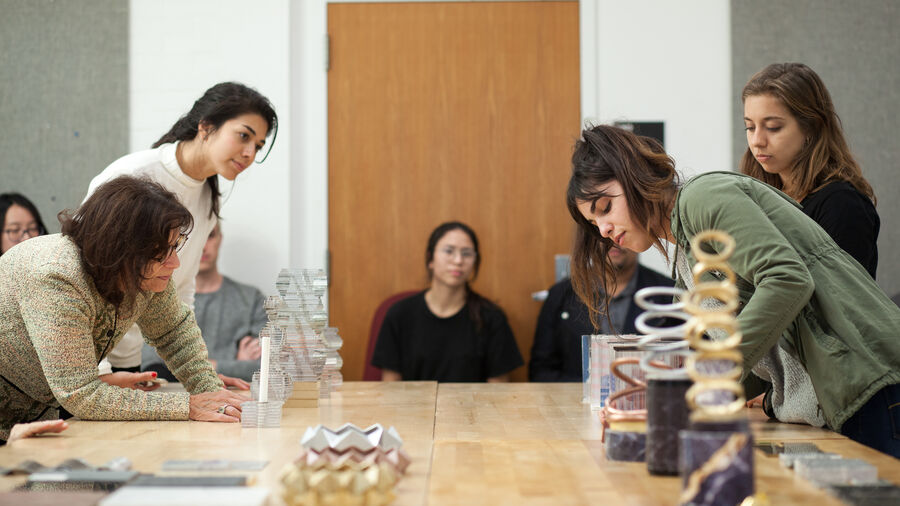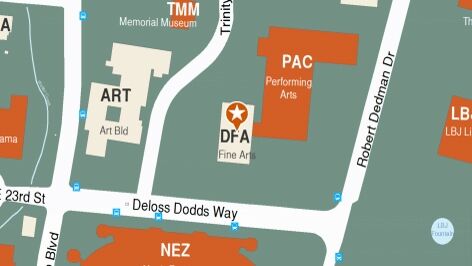Design
Major in the College of Fine Arts

The undergraduate Design program offers students a rich, multi-faceted educational experience that prepares graduates for careers in design, professions with a design component or entrepreneurial endeavors.
Design should always be about solving a problem and creating new processes, products and services for people. Because design is human-centered and always supports the end-user’s needs, both wants and limitations are explored at all stages within the design process and development lifecycle.
Students enjoy the extensive offerings of one of the world’s great public research universities while receiving individualized instruction from expert, passionate faculty and local industry professionals in small cohorts. Students are immersed in various aspects of design and are able to create graphics, objects, interactions, systems and services.
A design education gives students the skills to push past obvious solutions and extensive experience working in diverse teams. Students learn how to be comfortable with ambiguity, navigate problems, and design open-ended solutions with creative confidence.
As students continue in the Design program, studio-based courses develop their research, problem-solving and critical thinking/making skills, while elective courses and the university’s core curriculum emphasize the liberal arts. In their junior year, students must complete at least one professional internship (required as part of the B.F.A. degree). In their senior year, Design students undertake a capstone design project, and B.F.A. students show their work in a public exhibition at the Visual Arts Center.
Freshman and External Transfer Admission
ShowProspective University of Texas at Austin students should visit UT Admissions to learn about the application process and how to declare your major.
For more information regarding declaration requirements, visit the School of Design & Creative Technologies admissions page. Please note, applicants to the B.A. and B.F.A. Design majors are required to submit additional creative requirements alongside their general university application.
Internal Transfer Requirements
ShowUndergraduates currently enrolled in another college or school at The University of Texas at Austin who wish to add/change their major to Design must submit an internal transfer application.
Learn more about the internal transfer admissions process and its requirements.
For internal transfer, priority consideration will be given to students who demonstrate a timely pathway to graduation and who have a 3.0 or higher GPA. Current UT Austin students should review the university’s policies on internal transfer. It is highly recommended that students review the Design degree guidelines before applying.
Have any questions? Email or schedule an admissions chat with the SDCT Undergraduate Admissions Coordinator. Applications are only accepted for each Fall semester, updated details on the Internal Transfer Application portal + future SDCT Internal Transfer Info Sessions will be listed here.
Specializations
ShowB.F.A. vs B.A.
The Design B.F.A. (Bachelor of Fine Arts) is a pre-professional degree program encompassing typography, image creation/manipulation, interaction design and 3-D design that is intended to prepare students for employment in the field of design. B.F.A. students take approximately two-thirds of their undergraduate courses in Design and related coursework and culminate their studies by completing one or more paid professional internships. Additionally, B.F.A. students undertake a substantial capstone design project and present their work in an annual public exhibition. By choosing from a wide range of pre-approved supportive courses in fields across the university, B.F.A. students acquire not only the visual discernment and technical skills necessary to gain employment or admission to graduate school, but also the capacity for research, critical thinking, writing and speaking that enables them to rise to positions of creative leadership as designers, art directors, project managers, executives and entrepreneurs.
The Design B.A. (Bachelor of Arts) is an equally rich and rigorous exploration of design as a field, but is intended for students who prefer the flexibility and breadth of a liberal arts degree to the more studio-intensive, pre-professional B.F.A. degree. B.A. students acquire a solid foundation in design techniques, aesthetics, research methods, history and theory, while maintaining the flexibility to explore additional disciplines across the university. The B.A. degree’s flexibility makes it a particularly good choice for external or internal transfers or students who want to add a simultaneous major. B.A. students enroll side-by-side with B.F.A. students in rigorous introductory design studio courses. In their final two years of study, B.A. students take fewer upper-division studio courses.
Personality
ShowTo learn more about the experience within each of our majors in our School of Design & Creative Technologies (SDCT), check out the Showcase page. To see what type of professional industries our students get connected with, check out the Industry Relations resources.
Skills
ShowDesign majors develop technical, communication, artistic, and problem solving skills applicable to many areas of design. Specific skills developed by design majors depend to some degree on their creative interests.
Technology is both an important tool in design ideation and realization and a major and pervasive component of the fabric which constitutes contemporary culture. From this standpoint, students are asked to investigate a range of enabling technologies as they bear on culture and on the design process, and to question how technology affects their personal methodology. Although computers are used as a tool throughout the Design program, no course is specifically written to emphasize computers. Within the design area students have access to several well-equipped labs, each tailored to a specific technology. These are traditional letterpress printing, black and white photography, graphic arts photography, and the relatively new and constantly expanding digital technology. The skills learned are transferable to a variety of sectors and jobs.
